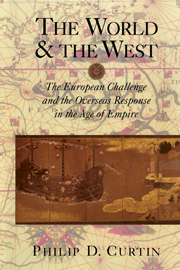Book contents
- Frontmatter
- Contents
- Preface
- Part One Conquest
- Part Two Culture Change and Imperial Rule
- Part Three Conversion
- Part Four Independence and the Liquidation of Empires
- 11 Non-European Resistance and the European Withdrawal
- 12 Personal and Utopian Responses
- 13 The Search for Viable Independence: Indonesia
- 14 Paths to Viable Independence: Ghana
- Afterword
- Index
14 - Paths to Viable Independence: Ghana
Published online by Cambridge University Press: 05 June 2012
- Frontmatter
- Contents
- Preface
- Part One Conquest
- Part Two Culture Change and Imperial Rule
- Part Three Conversion
- Part Four Independence and the Liquidation of Empires
- 11 Non-European Resistance and the European Withdrawal
- 12 Personal and Utopian Responses
- 13 The Search for Viable Independence: Indonesia
- 14 Paths to Viable Independence: Ghana
- Afterword
- Index
Summary
The process of nation building in Ghana was very different from that of Indonesia and probably more successful. Ghana is unlike Indonesia in many respects. The two countries are on nearly opposite sides of the globe. Their cultures have little in common. Though both are tropical, all of the Gold Coast hinterland that became Ghana is a region of shifting cultivation, with no wet-rice areas capable of sustaining a dense population. The territory of Indonesia is diverse and scattered over a vast area, with a population at independence of about 85 million, against 6 million for Ghana. Yet, for all of these differences, their historical experience has much in common.
Both regions first met Europeans in the guise of trading-post empires. The Portuguese fort at Elmina on the Gold Coast was begun in 1481, and Columbus visited there before he went on to discover America. The Dutch base at Batavia on Java was established in 1619, more than a century later. The move from trade enclaves to territorial empire, however, had much the same timing for the Gold Coast and the Netherlands Indies. In spite of an earlier Dutch overrule on Java, their conquest of northern Sumatra occurred simultaneously with the British seizure of Asante and its hinterland in the 1890s. In Ghana and the Netherlands Indies alike, anticolonial protest movements appeared even before the conquest was complete, and both countries gained formal independence in the 1950s.
- Type
- Chapter
- Information
- The World and the WestThe European Challenge and the Overseas Response in the Age of Empire, pp. 253 - 274Publisher: Cambridge University PressPrint publication year: 2000

